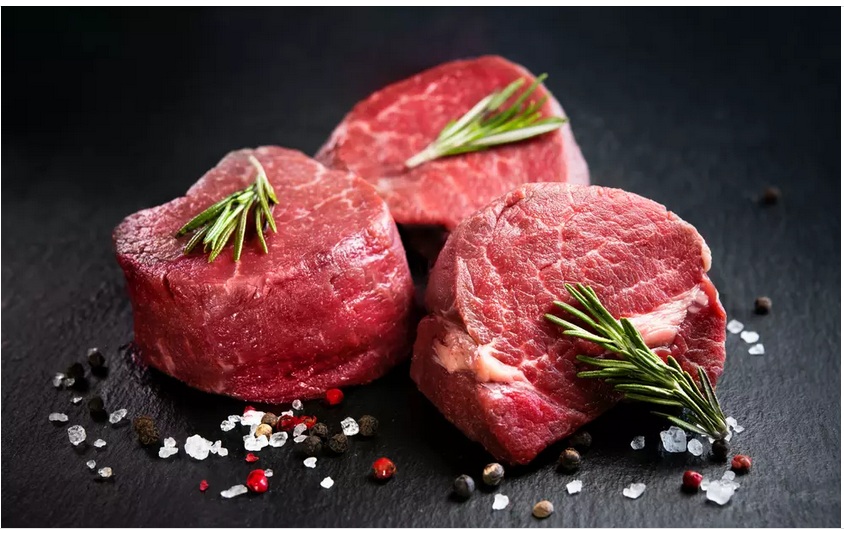Before starting any discussion about meat, we first need to know which red meat we are talking about? It’s important to highlight that there are various types of cuts, for example, patinho, coxão mole, coxão duro, file mignon. The difference between these types of cuts lies primarily in the amount of fat.
Do you know the difference between unprocessed red meat and processed red meat?

Photo: Alexander Raths/ Shutterstock
Evaluating scientific literature, processed red meat, such as bacon, ham, sausages, salami, and canned meat, consistently yields worse effects compared to unprocessed, or in natura, red meat, such as beef, veal, lamb, mutton, pork, or goat. This reinforces the need to prefer unprocessed red meat and, whenever possible, to vary its sources. Thus, opting for leaner, unprocessed cuts can be a way to keep red meat on your plate more frequently. This is because many problems related to red meat consumption arise from excessive saturated fat intake.
Saturated fat raises cholesterol (LDL-c), known as “bad cholesterol,” which increases the formation of fatty plaques in blood vessels. What does this mean? It’s as if our arteries experience a major traffic jam, preventing blood from reaching its destination, causing the death of body tissues supplied by these blood vessels.
How red meat is prepared also matters! Cooked, roasted, and grilled preparations are always more recommended than fried and breaded ones. And finally, how much do you consume? Defining portion size is not simple, but quantities of approximately 100 g/day (considering a raw portion) seem adequate. Furthermore, it is suggested to limit consumption to two to three times per week.
Why is there so much concern about red meat?
A scientific study published in the journal JAMA (Zhong et al., 2020), recognized for high-quality publications, showed that high consumption of unprocessed red meat increased the risk of cardiovascular diseases by only 3%.
Although the study drew attention to red meat consumption, some details are important. One is that the study could not differentiate the type of red meat preparation; that is, it did not distinguish whether it was fried, breaded, roasted, or grilled. Another issue is that the study was conducted only with people from the United States, whose dietary pattern is worse compared to that of Brazilians. Despite these study limitations, the results are interesting and guide us to consume red meat in moderation.
Other studies, however, have shown contradictory results. For example, a study published in Critical Reviews in Food Science and Nutrition found no association between the consumption of unprocessed red meat and cases of ischemic stroke or coronary heart disease (de Medeiros et al., 2023).
Another robust study published in The Lancet suggests that replacing processed red meat with unprocessed meat or poultry reduces the risk of type 2 diabetes mellitus (Li et al., 2024), while another, also published in The Lancet, suggests that reducing processed red meat intake promotes positive effects (Kennedy, Alexander, Taillie, & Jaacks, 2024).
What does all this mean? A yellow light. There is no encouragement to eat a lot, but there is also no encouragement to exclude red meat from your plate. It is therefore essential to consume adequate amounts.
Another robust study published in The Lancet suggests that replacing processed red meat with unprocessed meat or poultry reduces the risk of type 2 diabetes mellitus (Li et al., 2024), while another, also published in The Lancet, suggests that reducing processed red meat intake promotes positive effects (Kennedy, Alexander, Taillie, & Jaacks, 2024).
What does all this mean? A yellow light. There is no encouragement to eat a lot, but there is also no encouragement to exclude red meat from your plate. It is therefore essential to consume adequate amounts.
Separate the wheat from the chaff!
Scientific studies also evaluate the size of the effect (negative or positive) according to who consumes red meat. If you are healthy, the effect of red meat is small or non-existent. Therefore, it is essential to establish a healthy lifestyle, with good quality sleep and an adequate level of physical activity. If you are overweight, a smoker, or consume alcoholic beverages more frequently and have other metabolic diseases (e.g., diabetes mellitus), greater attention is needed.
Consider the whole picture

Photo: Yulia Furman/ Shutterstock
No single food on its own causes disease. The effects that foods have on our health occur in combination. Therefore, a person who eats a large amount of red meat and no vegetables will experience completely different outcomes from someone who consumes both red meat and vegetables appropriately. Pay attention and increase the variety of foods on your plate, also taking into account the current recommendations from the scientific literature:
- Poultry and fish: preferred;
- Fresh red meat: consume in moderation;
- Processed red meat: avoid or consume only occasionally;
- Vegetables, leafy greens and legumes: always.





